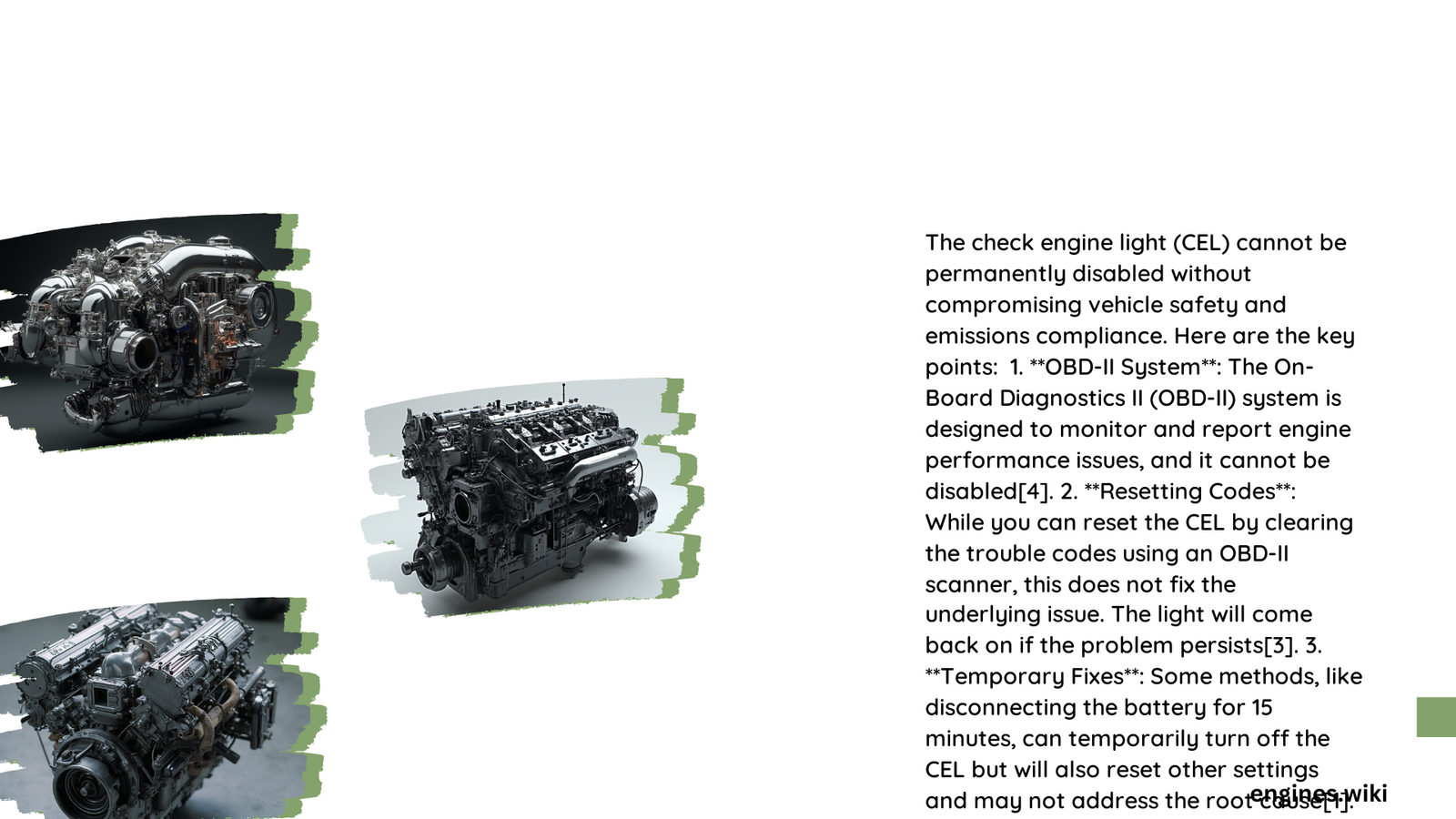The check engine light is a crucial indicator of potential vehicle issues. While it’s possible to disable the check engine light through various methods, it’s generally not recommended due to safety and legal concerns. This article explores the methods, risks, and implications of disabling the check engine light, as well as proper ways to address the underlying issues.
Can the Check Engine Light Be Temporarily Disabled?
Yes, the check engine light can be temporarily disabled through several methods:
- Battery Disconnection:
- Disconnect the negative terminal of the battery
- Wait for 15 minutes
-
Reconnect the terminal
-
OBD-II Scanner:
- Connect an OBD-II scanner to the vehicle’s port
-
Clear the error codes
-
Ignition Cycle Method:
- Turn the ignition on and off three times consecutively
- This may work for some vehicles
What Are the Risks of Permanently Disabling the Check Engine Light?

Permanently disabling the check engine light is not recommended due to several risks:
- Safety Concerns: Masking potential serious engine issues
- Legal Issues: Failing emissions tests in many jurisdictions
- Increased Repair Costs: Ignoring minor problems can lead to major repairs
- Reduced Vehicle Performance: Unaddressed issues may affect overall performance
How to Properly Reset the Check Engine Light?
To properly reset the check engine light:
- Diagnose the issue using an OBD-II scanner
- Address the underlying problem
- Clear the error codes using the scanner
| Step | Action | Tool Required |
|---|---|---|
| 1 | Diagnose | OBD-II Scanner |
| 2 | Repair | Varies based on issue |
| 3 | Reset | OBD-II Scanner |
What Are Common Check Engine Light Codes?
Common check engine light codes include:
- P0xxx: Generic codes for all vehicles
- Example: P0128 – Coolant Temperature Below Thermostat Regulating Temperature
- P1xxx: Manufacturer-specific codes
- Example: P1000 – Ford-specific code for ‘KOER’ test not completed
What Are the Long-term Effects of Ignoring the Check Engine Light?
Ignoring the check engine light can lead to:
- Increased fuel consumption
- Reduced engine performance
- Potential for catastrophic engine failure
- Higher repair costs over time
- Decreased vehicle resale value
Are There Legal Implications of Disabling the Check Engine Light?
Yes, there are legal implications:
- Many jurisdictions require vehicles to pass emissions tests
- Disabling the check engine light may be considered tampering with emissions equipment
- Fines and penalties may apply for non-compliance
What Should You Do When the Check Engine Light Comes On?
When the check engine light illuminates:
- Check for immediate safety concerns (unusual noises, smoke, etc.)
- Use an OBD-II scanner to read the error code
- Research the code or consult a professional mechanic
- Address the underlying issue promptly
- Reset the light only after repairs are completed
Can Different Vehicle Types Affect Check Engine Light Disablement?
Yes, vehicle types can affect check engine light disablement:
- Post-1996 Vehicles: Equipped with OBD-II systems, allowing for easy code reading and clearing
- Pre-1996 Vehicles: May require different methods, often involving battery disconnection
- Hybrid/Electric Vehicles: May have unique systems and codes requiring specialized knowledge
In conclusion, while it is possible to disable the check engine light, it’s crucial to address the underlying issues for safety, legal compliance, and optimal vehicle performance. Always consult a professional mechanic when in doubt about vehicle warning lights.
References:
1. YouTube: How To Turn Off Check Engine Light Without Special Tools
2. YouTube: 4 Step Guide On How to Disable Check Engine Light Permanently
3. Car and Driver: Reset a Check Engine Light at Your Own Risk
